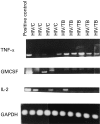Impact of tuberculosis (TB) on HIV-1 activity in dually infected patients
- PMID: 11207653
- PMCID: PMC1905977
- DOI: 10.1046/j.1365-2249.2001.01401.x
Impact of tuberculosis (TB) on HIV-1 activity in dually infected patients
Abstract
Active TB in HIV-1-infected subjects is associated with increased HIV-1-related immunodeficiency and mortality. We assessed plasma viral load in HIV-1-infected patients with pulmonary TB (HIV/TB) and non-TB symptomatic HIV-1-infected patients (HIV). HIV-1 load was higher in HIV/TB compared with HIV at higher CD4 counts (> 500/microl) (P < 0.01), but not at lower CD4 counts (< 500/microl). We also evaluated the status of HIV-1 gene expression in peripheral blood mononuclear cells (PBMC) and serum from HIV/TB and CD4-matched healthy HIV-infected patients (HIV/C) by reverse transcriptase-polymerase chain reaction over a range of CD4 (> 900/microl to < 200/microl). HIV-1 RNA in serum and PBMC correlated to one another, and both were markedly higher in HIV/TB compared with HIV/C with higher CD4 counts. Also, during a longitudinal study of anti-tuberculous chemoprophylaxis in HIV-1-infected patients, 10 subjects who developed TB had serologies before, at the time, and after the diagnosis of TB. These HIV/TB patients had an increase in viral load (average 2.5-fold) at the time of diagnosis of TB (P < 0.05). Overall, these data indicate that the transcriptional activity of HIV-1 is enhanced in HIV-1-infected patients with active TB, especially during early HIV-1 disease. As TB often is an early HIV-1 opportunistic infection, it may particularly favour early viral replication and dissemination, and therefore contribute to progression of HIV-1 disease.
Figures




Similar articles
-
Spectrum of immunodeficiency in HIV-1-infected patients with pulmonary tuberculosis in Zaire.Lancet. 1993 Jul 17;342(8864):143-6. doi: 10.1016/0140-6736(93)91346-n. Lancet. 1993. PMID: 8101257
-
Dynamic variation in the cellular origin of HIV type 1 during treatment of tuberculosis in dually infected subjects.AIDS Res Hum Retroviruses. 2007 Jan;23(1):93-100. doi: 10.1089/aid.2006.0050. AIDS Res Hum Retroviruses. 2007. PMID: 17263638
-
Characteristics of HIV-infected tuberculosis patients in Thailand.Southeast Asian J Trop Med Public Health. 2009 Jan;40(1):93-103. Southeast Asian J Trop Med Public Health. 2009. PMID: 19323040
-
Virological and immunological impact of tuberculosis on human immunodeficiency virus type 1 disease.J Infect Dis. 2003 Oct 15;188(8):1146-55. doi: 10.1086/378676. Epub 2003 Sep 30. J Infect Dis. 2003. PMID: 14551885 Review.
-
Impact of tuberculosis on HIV-1 replication, diversity, and disease progression.AIDS Rev. 2002 Jul-Sep;4(3):165-76. AIDS Rev. 2002. PMID: 12416451 Review.
Cited by
-
Malaria parasitemia and CD4 T cell count, viral load, and adverse HIV outcomes among HIV-infected pregnant women in Tanzania.Am J Trop Med Hyg. 2010 Apr;82(4):556-62. doi: 10.4269/ajtmh.2010.09-0477. Am J Trop Med Hyg. 2010. PMID: 20348498 Free PMC article.
-
HIV-1 replication is differentially regulated by distinct clinical strains of Mycobacterium tuberculosis.PLoS One. 2009 Jul 1;4(7):e6116. doi: 10.1371/journal.pone.0006116. PLoS One. 2009. PMID: 19568431 Free PMC article.
-
Trend of some Tuberculosis Indices in Iran during 25 yr Period (1990-2014).J Res Health Sci. 2016 Summer;16(3):141-146. J Res Health Sci. 2016. PMID: 27840342 Free PMC article.
-
Cigarette smoking is associated with high HIV viral load among adults presenting for antiretroviral therapy in Vietnam.PLoS One. 2017 Mar 7;12(3):e0173534. doi: 10.1371/journal.pone.0173534. eCollection 2017. PLoS One. 2017. PMID: 28267790 Free PMC article.
-
Effects of antiretroviral therapy on immune function of HIV-infected adults with pulmonary tuberculosis and CD4+ >350 cells/mm3.J Infect Dis. 2011 Apr 1;203(7):992-1001. doi: 10.1093/infdis/jiq141. J Infect Dis. 2011. PMID: 21402550 Free PMC article. Clinical Trial.
References
-
- Dye C, Scheele S, Pathania V, Raviglione MC. Consensus statement. Global burden of tuberculosis: estimated incidence, prevalence, and mortality by country. WHO Global Surveillance and Monitoring Project. JAMA. 1999;282:677–86. - PubMed
-
- Kumar S. WHO gives southeast Asia a health warning. Lancet. 1999;354:1010–1. - PubMed
-
- Lucas S, Nelson AM. Tuberculosis: pathogenesis, protection, and control. Washington, DC: ASM Press; 1994. Pathogenesis of tuberculosis in human immunodeficiency virus-infected people; pp. 503–13.
-
- Whalen C, Horsburgh CR, Hom D, Lahart C, Simberkoff M, Ellner J. Accelerated course of human immunodeficiency virus infection after tuberculosis. Am J Respir Crit Care Med. 1995;151:129–35. - PubMed
-
- Orenstein JM, Fox C, Wahl SM. Macrophages as a source of HIV during opportunistic infections. Science. 1997;276:1857–60. - PubMed
Publication types
MeSH terms
Grants and funding
LinkOut - more resources
Full Text Sources
Medical
Research Materials

